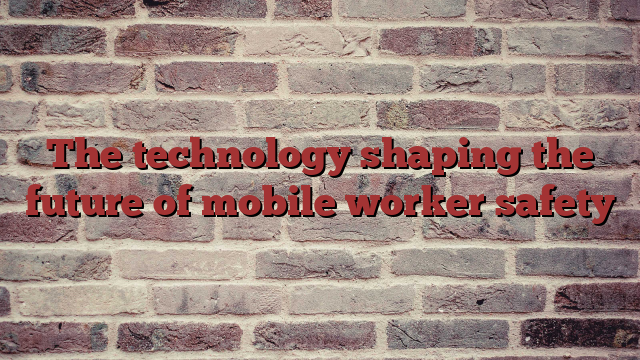Ensuring the safety of mobile workers stands at the forefront of today’s workplace priorities. As technology continually evolves, its role in safeguarding those working remotely or on the move becomes increasingly vital. This blog aims to explore the significant strides technology has made in shaping the landscape of mobile worker safety.
The Current Landscape of Mobile Worker Safety
- Defining Mobile Worker Safety
When we speak of mobile worker safety, we refer to the measures and protocols aimed at protecting individuals engaged in tasks outside conventional office settings. These workers face diverse hazards, from construction sites to delivery routes, necessitating specialized safety considerations.
- Understanding the Challenges
Statistics paint a sobering picture, indicating higher accident rates among mobile workers compared to their stationary counterparts. Challenges encompass various factors, including the lack of immediate access to safety resources and the unpredictability of external environments.
- Compliance and Safety Standards
Governments and organizations have implemented stringent regulations to address these safety concerns. These standards aim to mitigate risks and ensure adherence to safety protocols across industries.
Role of Technology in Enhancing Mobile Worker Safety
Wearable Devices: Guardians on the Go
Innovative wearable technology, such as smart helmets or vests embedded with sensors, plays a pivotal role. These devices enable real-time monitoring of vital signs, location tracking, and immediate alerts in case of emergencies.
IoT Applications: Remote Safety Management
The Internet of Things (IoT) interconnects devices, allowing for seamless communication and data sharing. In the realm of worker safety, IoT facilitates remote monitoring of machinery, environmental conditions, and hazard detection, enhancing preemptive safety measures.
AI-Powered Risk Assessment: Predictive Insights
Artificial Intelligence (AI) algorithms analyze vast datasets to predict potential risks. These predictive analytics offer invaluable insights into identifying hazardous scenarios before they unfold, enabling proactive safety interventions.
Communication and Emergency Response Systems
Technological advancements have revolutionized communication channels for mobile workers. Dedicated applications and platforms ensure swift and effective communication during emergencies, enabling prompt response and assistance.
Advancements and Innovations
- Robotics and Automation
Innovations in robotics have introduced autonomous systems designed to assist and protect workers in hazardous environments. These robots can handle tasks in dangerous settings, reducing the need for human intervention in high-risk scenarios.
- Virtual Reality (VR) and Augmented Reality (AR)
VR and AR technologies offer immersive training experiences for mobile workers. Simulated environments allow workers to practice safety protocols in realistic scenarios, enhancing their preparedness for potential hazards.
- Drones for Surveillance and Inspection
Drones equipped with cameras and sensors play a significant role in surveillance and inspection tasks. They can access hard-to-reach areas, monitor safety conditions, and provide real-time data without exposing workers to risky environments.
Case Studies Demonstrating Technological Impact
- Smart Personal Protective Equipment (PPE)
Incorporating technology into PPE, such as helmets or vests with embedded sensors, has shown remarkable results. These smart devices monitor vital signs, detect hazards, and send alerts, significantly reducing the risk of workplace accidents.
- AI-Powered Predictive Analytics
The utilization of AI-driven predictive analytics has transformed safety management. By analyzing vast datasets, AI predicts potential risks, allowing proactive interventions and preventing accidents before they occur.
Future Prospects and Potential Developments
- Edge Computing for Real-Time Decision Making
The integration of edge computing with safety technology enables immediate data processing at the device level. This real-time analysis facilitates quick decision-making, crucial in time-sensitive safety situations.
- Advancements in Biometric Safety Measures
Biometric technologies, such as fingerprint or iris scanning, are evolving for enhanced safety authentication. These measures offer secure access to restricted areas while ensuring only authorized personnel operate critical machinery.
Read More – Field Management Software
Ethical and Privacy Considerations
- Balancing Safety and Privacy
Ensuring mobile worker safety through technology raises ethical concerns regarding the delicate balance between safeguarding individuals and respecting their privacy. Companies must navigate this terrain delicately, prioritizing safety without compromising the privacy rights of their employees.
- Ethical Use of Technology
Employers need to establish clear guidelines on the ethical use of monitoring technologies. Transparent policies and open communication foster trust among workers and address concerns related to intrusive monitoring practices.
- Legal Implications
The deployment of technology in ensuring worker safety necessitates compliance with legal frameworks. Organizations must align their safety measures with existing privacy laws and regulations to avoid potential legal ramifications.
Challenges and Limitations
- Technical Hurdles
Implementing safety technologies often encounters technical challenges. Compatibility issues among various devices, software integration complexities, and connectivity problems can hinder the seamless functioning of safety systems.
- Human Factors
While technology plays a pivotal role, human factors significantly influence safety outcomes. Factors such as adherence to safety protocols, training efficacy, and the psychological aspect of worker behavior pose challenges to the effectiveness of safety tech.
- Cost and Scalability
The adoption of sophisticated safety technology comes with financial considerations. The initial investment and ongoing maintenance costs might pose challenges, particularly for smaller businesses. Scalability issues in deploying these solutions across diverse work environments also warrant attention.
Best Practices and Recommendations
Integration Strategies
Successful integration of safety technology involves aligning it seamlessly with existing safety protocols and workflows. Companies should conduct thorough assessments to identify gaps and opportunities where technology can augment safety measures. Prioritizing solutions that complement the current operational framework ensures a smooth integration process and fosters user acceptance.
Training and Education
Comprehensive training programs are instrumental in ensuring the effective utilization of safety technologies. Organizations should invest in training modules that cater to various skill levels and job roles, fostering proficiency and confidence among workers. These programs not only familiarize employees with the functionalities of safety tech but also emphasize the importance of adhering to safety protocols.
Collaborative Initiatives
Industry-wide collaboration plays a pivotal role in advancing mobile workforce management. Establishing partnerships and forums where stakeholders can share best practices, technological advancements, and lessons learned fosters a collective effort towards improving safety standards. Collaborative initiatives facilitate the development of standardized safety protocols that benefit the entire workforce, transcending individual organizational boundaries.
Regular Evaluation and Improvement
Continuous evaluation of the effectiveness of safety technologies is essential. Companies should regularly assess the performance of implemented solutions, gather feedback from workers, and make necessary adjustments or upgrades. This iterative process ensures that safety measures evolve to meet the changing needs and challenges faced by mobile workers.
Conclusion
Technology’s transformative influence on mobile worker safety is undeniable. As we navigate the ever-evolving landscape, the synergy between technological innovation and ethical considerations will continue to shape the future of ensuring the well-being of mobile workers.



